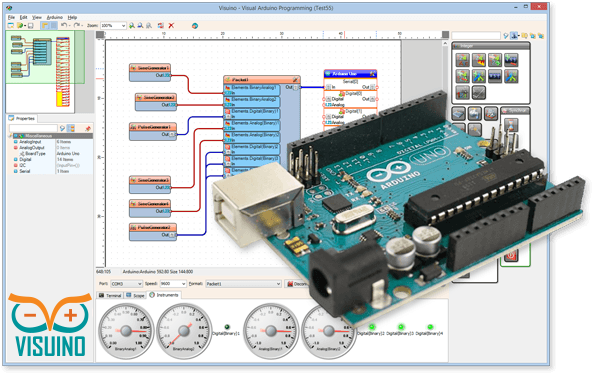

- Arduino programming language wiki generator#
- Arduino programming language wiki full#
- Arduino programming language wiki Bluetooth#
- Arduino programming language wiki series#
If a wireless connection is required, it can be easily connected to the ESP32-C/S/H series.ĮSP32 is housed in quad-flat no-leads (QFN) packages of varying sizes with 49 pads.
Arduino programming language wiki Bluetooth#
Wi-Fi and Bluetooth are not implemented. Integrated hardware accelerators for various media encoding protocols, including H.264. 768 KB SRAM on high-performance core system. Low performance single-core 32-bit RISC-V CPU, up to 40 MHz. High performance dual-core 32-bit RISC-V CPU, up to 400 MHz. IEEE 802.11ax (Wi-Fi 6) on 2.4 and 5 GHz, supporting 20 MHz bandwidth in 11ax mode, 20 or 40 MHz bandwidth in 11b/g/n mode. Single-core 32-bit RISC-V CPU, up to 240 MHz. Single-core 32-bit RISC-V CPU, up to 96 MHz. 30 (QFN40) / 22 (QFN32) programmable GPIOs. IEEE 802.11ax (Wi-Fi 6) on 2.4 GHz, supporting 20 MHz bandwidth in 11ax mode, 20 or 40 MHz bandwidth in 11b/g/n mode. Low power 32-bit RISC-V CPU, up to 20 MHz, implementing RV32IMAC. High performance 32-bit RISC-V CPU, up to 160 MHz, implementing RV32IMAC. Ultra-low power FSM coprocessor similar to previous ESP32 and ESP32-S2. Ultra-low power RISC-V (RV32IMC) coprocessor clocked at 17.5 MHz approximately. Capable of connecting to external PSRAM and Flash via Quad SPI or Octal SPI, and share the same 32 MiB address space. 512 KiB SRAM, 384 KiB ROM, and 16 KiB RTC SRAM. Added instructions to accelerate machine learning applications. Dual-core Xtensa LX7 CPU, up to 240 MHz, and supporting single-precision FPU. 400 KiB SRAM, 384 KiB ROM, and 8 KiB RTC SRAM. Single-core 32-bit RISC-V CPU, up to 160 MHz. 320 KiB SRAM, 128 KiB ROM, and 16 KiB RTC SRAMĮSP32-C3 NodeMCU board with an ESP32-C3-32S. Single-core Xtensa LX7 CPU, up to 240 MHz. Xtensa single-/dual-core 32-bit LX6 microprocessor(s). Additionally, the original ESP32 was revised (see ESP32 ECO V3, for example). These chips have different CPUs and capabilities, but all share the same SDK and are largely code-compatible. They form the ESP32 family of microcontrollers. 
Since the release of the original ESP32, a number of variants have been introduced and announced. Wake up from GPIO interrupt, timer, ADC measurements, capacitive touch sensor interrupt.
Arduino programming language wiki generator#
Cryptographic hardware acceleration: AES, SHA-2, RSA, elliptic curve cryptography (ECC), random number generator (RNG).1024-bit OTP, up to 768-bit for customers.IEEE 802.11 standard security features all supported, including WPA, WPA2, WPA3 (depending on version) and WLAN Authentication and Privacy Infrastructure (WAPI).
Arduino programming language wiki full#
Pulse counter (capable of full quadrature decoding). Infrared remote controller (TX/RX, up to 8 channels). Ethernet MAC interface with dedicated DMA and planned IEEE 1588 Precision Time Protocol support. SD/ SDIO/ CE-ATA/ MMC/ eMMC host controller. 10 × touch sensors ( capacitive sensing GPIOs). Bluetooth: v4.2 BR/EDR and BLE (shares the radio with Wi-Fi). CPU: Xtensa dual-core (or single-core) 32-bit LX6 microprocessor, operating at 160 or 240 MHz and performing at up to 600 DMIPS. ESP32 Die shotįeatures of the ESP32 include the following: It is a successor to the ESP8266 microcontroller.įeatures ESP32 function block diagram. ESP32 is created and developed by Espressif Systems, a Shanghai-based Chinese company, and is manufactured by TSMC using their 40 nm process. Arduino programming language wiki series#
The ESP32 series employs either a Tensilica Xtensa LX6 microprocessor in both dual-core and single-core variations, Xtensa LX7 dual-core microprocessor or a single-core RISC-V microprocessor and includes built-in antenna switches, RF balun, power amplifier, low-noise receive amplifier, filters, and power-management modules. Tensilica Xtensa LX6 microprocessor 160 or 240 MHzĮSP32 is a series of low-cost, low-power system on a chip microcontrollers with integrated Wi-Fi and dual-mode Bluetooth.

ESP-WROOM-32 module with ESP32-D0WDQ6 chip







 0 kommentar(er)
0 kommentar(er)
